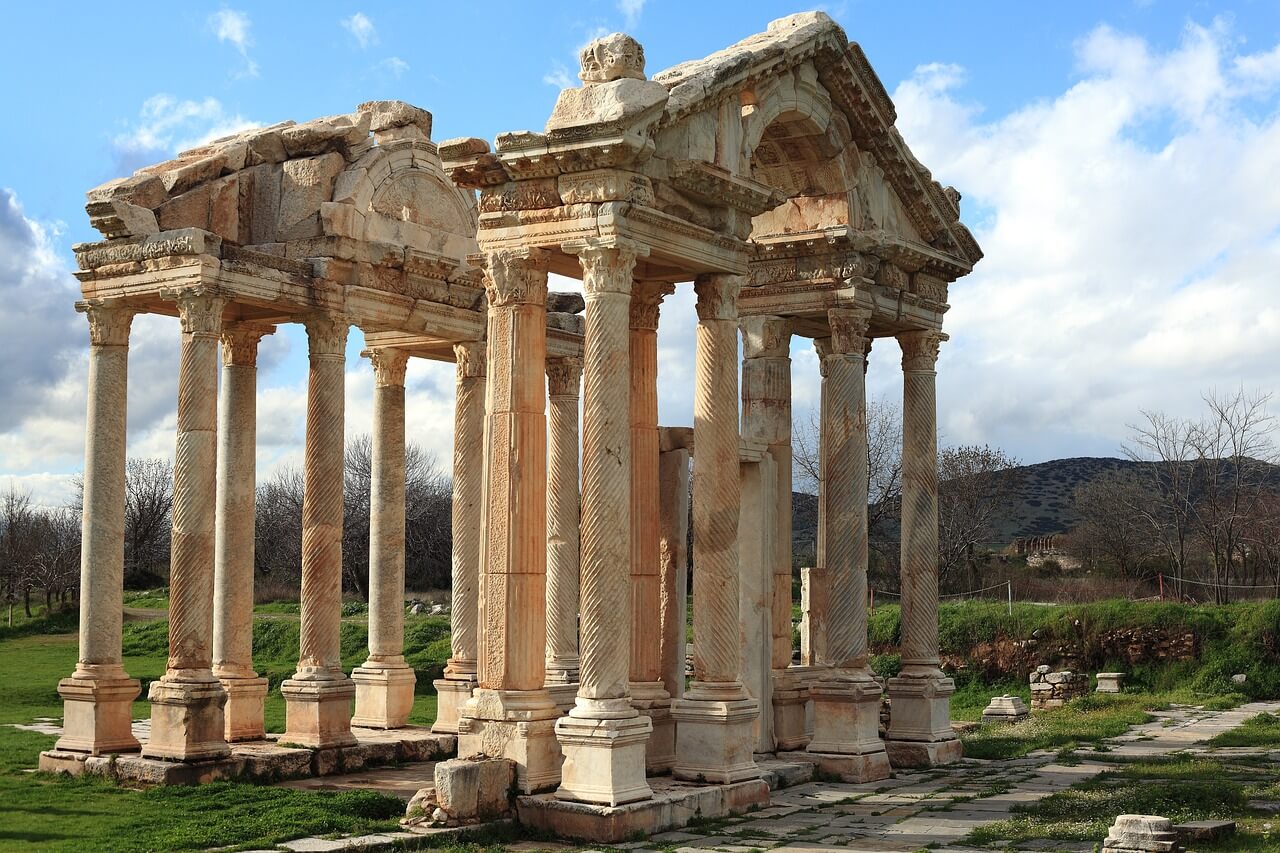Where does Western Culture Begin?
Western cultural origins are traced back to ancient Greece and perhaps beyond that to the hard-to-define cultures of the Indo-Europeans. These cultures are very distant from our modern society, and yet, there is the root of many cultural norms that we take for granted.
The ancient Greeks and Romans gave us stories that were precursors to modern fairy tales such as Ovid’s Metamorphoses and Cupid & Psyche. These ancient cultures also gave us the origins of art and textiles. The fundamental structure of textiles remains the same since ancient times.
How does the creation of textiles, the creation of fairy tales, and the transformation of both over the centuries all tie in together?
The Greek Fates, or Moirai, are considered to be the foundation for both cloth making and the fairy tale genre.
The three female fates (also represented in Norse mythology) spun the thread of life for each person on Earth. One fate took the fluff of wool and started the twist that turns a soft unformed material into a strong and durable thread. The next fate measured the length of the thread–this correlates to the length of a person’s life. And the third fate snipped the thread–the end of life. In this way the fates were responsible for the beginnings of structural cloth, the length of life, and the story that life made.
The position of the Fates in ancient Greek and Roman cultures evolved into the Roman nature goddess, named Bona Dea. She, in turn, shows up in fairy tales as various nature goddesses, and what we call today fairy godmothers. The fairy godmother type of character has the ability to change the fate of the protagonist–this is the key link to these ancient beings the fates who were responsible for each life of humanity.
This is the first transformation–the fates into the fairy godmother.
The act of transformation is evident in almost any fairy tale. A mermaid turns into a human–a maid becomes a princess–a young girl becomes a mother. Transformations are the reason for fairy tales–how does someone turn into a new person, or achieve a new reason for life?
Transformations are also evident in textile making–in particular woven fabric. A woven textile began life as sheep’s wool or a flax plant. The raw material is transformed first into thread and then into cloth.

Origins of Textile Making
In order to create a fabric, the maker must adhere to the rules of weaving—which are largely guided by the properties of physics. Give a trained weaver a ball of thread and she can create a cloth, but only a trained weaver would understand the steps involved. The thread must first be tested for its strength—a structure does not stand on weakness. The thread is mapped out for the length and breadth of the project. The warp threads are held in order by creating a cross that keeps the continuous lines of thread from getting tangled. The cross is made by mapping the thread into a long infinity symbol, this keeps the threads in their proper place. The long warp threads are then wrapped around a beam at the back (or top) of the loom, so that they can be released slowly as the cloth progresses. Each thread is strung through a heddle, which is made of string or medal, and keeps the threads straight and the pattern, if there is one, in place. The warp threads are attached to the front beam and tied to create proper tension across the surface. The tension must be even across the cloth and maintained throughout the project. A beater or comb is set in place, or a handheld comb can be used; a long comb that is used to beat each line of thread is preferred for an even cloth. Then the weft thread must be loaded on a shuttle. The warp and weft threads then enter the dance of over and under to create the familiar lattice of a woven cloth. While the weaver is creating the cloth, the edges require attention with each line of weft thread that is laid; if the weft is pulled too tightly (or not tightly enough) the edges will be uneven and difficult to work with later, plus it may affect the overall tension of the cloth. If foot pedals are used, these are connected to the heddles that hold each thread of the warp in place, and these are altered to create a pattern. There are countless variations that can take place within the regular steps involved, but the trained weaver knows what steps are necessary and what can be changed. These basic principles of weaving are unchanged through the centuries.
Archeologists continue to uncover ancient examples of Neolithic textiles that can be identified as spun and woven from sheep wool and flax plants. E.J.W Barber describes several discoveries from a Swiss site where textiles were dated to 3000 BCE, Faiyum Egypt in the fifth millennium, and a Turkish site revealed textile fragments from the sixth millennium. All these sites exhibited evidence of the textile fragments as well as implements for fabric production, i.e. spinning and weaving tools. Even with the production of innovative fabrics such as polyester and rayon, today’s textile industry still utilizes flax and wool for clothing, blankets, curtains, table linens, and more. The basics of cleaning and twisting a rough fiber to make it strong and durable and then also layering that thread over and under another thread have not changed since Neolithic times. The earliest examples of looms and spindles are similar to modern technology. It is a mystery how early civilizations first discovered how to use sheep’s wool or flax plants to create a cloth. Both of these are labor-intensive processes involving cleaning and preparing materials. The techniques of weaving and spinning use the same principles and only vary in appearance in ancient cultures around the world. The Greek-influenced ancient world used an upright or vertical loom, while, in South America, weavers still use a backstrap loom to create their cloth. Although the tools used by these ancient societies are different, the weaving of fabric that involves an over-under lattice of threads is the same structure.
One of the earliest and most captivating examples in the ancient world of weaving and its purpose is Penelope at her loom in The Odyssey. This is not only an example of common labor for a female, but it is also an example of the resourcefulness that a woman can employ as she utilizes her craft that men knew little about. It is easier to deceive someone when they have little knowledge of the technique employed. Given her difficult situation, Penelope delays marriage in the only way she can: utilizing her women’s work. The ancient Greeks used a vertical loom, and therefore Penelope’s weaving and subsequent un-weaving each night would look different today on a floor loom employed by most hobby weavers. The basic structure, however, remains unchanged; the weft threads that Penelope lays over and under the stretched warp threads would be removed. The thread itself would hold a slight kink from being crimped and un-crimped with the warp threads, but that too would be concealed by the ignorance of the suitors whom she is avoiding.

Transformation
Textiles and fairy tales are examples of transformation or metamorphosis. In order to become fabric, let alone a garment, sheep’s wool must be transformed. If that woolen fabric is to be dyed, a transformation akin to alchemy takes place involving plant material, metals, and minerals. Take a hank of freshly shorn wool, or a flax stalk, and envision it as cloth; when you are close and personal with these materials it is evident that the process from raw material to cloth involves many steps.
A lesser-known tale, The Little Flax Flower, describes the transformation of plants into cloth by following the story of two young women. This tale highlights the stages required to turn flax into linen, as well as the transformation from a young girl to a married woman. Fairy tales are full of literal and metaphorical transformations.
The metamorphosis of the characters in fairy tales can be both an external and internal process. In the British tale, Habetrot and Scantlie Mab, the main character is transformed from a lazy poor child into a prosperous and fortunate wife. Her fairy godmother is an older woman who helps the young girl by spinning her thread for her and giving the young girl all the credit.
The Six Swans is an example of a literal transformation in which seven brothers are changed into birds and then back into boys again. Their transformation was made possible by their devoted sister who sacrifices her voice while weaving their star shirts. The sister shows her strength and resilience in keeping to her vow to remain silent while making the enchanted shirts that will save her brothers.
The transformation in fairy tales is learned from the magic that occurs in ancient myths. Ovid’s Metamorphoses is an epic collection of poems about transformation, fairies, gods, and other creatures from the heavily Greek-influenced culture of ancient Rome. The Metamorphoses poems are just what the title suggests, stories of transformation. Characters including people, demi-gods, and nymphs are transformed into animals, stars, plants, and many other elements of creation. The foundational idea that Ovid built on is that everything around us has an origin in the metaphysical. He also retold and created explanations of how things came to be. The tale of the orb weaver, Arachne in the Metamorphoses, tells of a woman who is transformed into a spider—the ancestress of modern-day weavers.
The transformation of thread into cloth is a mirror of the transformation that takes place within a fairy tale. Both textiles and fairy tales represent change, disguise, or magic. In order for Rumpelstiltskin to create his magic, he transforms plain straw into gold thread. The curse that strikes Sleeping Beauty utilizes a spindle—an agent of the transformation process of fluff into thread. Wherever the origins, the past tells us that the ancient Greeks and Romans spun thread from animal fur and plant materials and they wove cloth using a weighted upright loom. They even have a goddess who oversaw the beauty of handiwork crafts—Athena/Minerva (Greek/Roman). The goddess of handiwork inherited this skill from her mother, Metis. Though, in ancient Greek myth Athena is often considered motherless, she had a mother who was eaten by Zeus while she was pregnant. Athena sprung from Zeus’ head and her mother Metis was never released from inside her captor. Athena inherited her skills of cunning, creativity, and craft from her mother. Minerva looks out for weavers and she is an adept herself, as demonstrated in Ovid’s tale, Arachne. The connection of Athena’s parentage with weaving demonstrates that skilled weavers must be creative and cunning. The goddess Athena/Minerva has many skills from warfare to handiwork; she is an example of metamorphosis within herself due to her unique parentage.
The principle of transformation is woven within the tale and the textile in form and function. Transformation is a key factor linking fairy tales with the ancient Greek world. What is similar between Homer’s Odyssey and Marion Zimmer Bradley’s The Mists of Avalon? What are the common threads in an ancient robe of rough wool and a modern-day pair of yoga pants made of stretchy spandex? Are these too different to be connected, or are they related at least in their purpose? The transformations in fairy tales usually come from a being: a witch, wizard, sorceress, or fairy. The yoga pants would not exist if it were not for the original invention of woolen fabric. The lineage of handspun wool to factory-made to manmade fibers is similar to the tradition of mythology to fairy tales to fantasy novels. Tolkien’s fantasy series, The Lord of the Rings, inspired the fantasy genre. His study of the culture and folklore of the British Isles and Scandinavia was the basis of his inspiration. The modern example does not exist without its predecessors. This is part of the process of transformation.
Everything in the present is connected in some way to the past.






